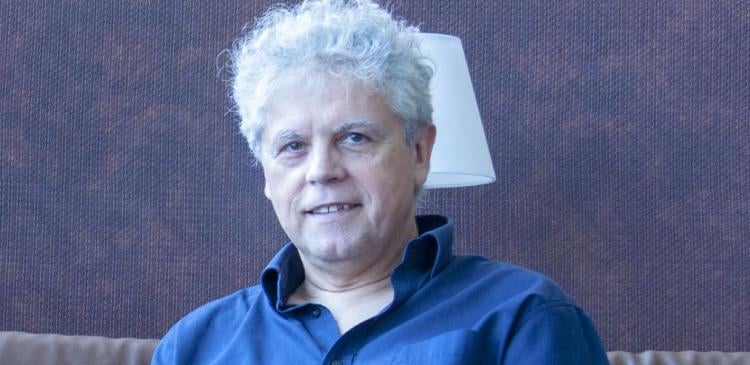Enzo di Fabrizio - Professor at King Abdullah University of Science and Technology (KAUST), Saudi Arabia - and his team have developed a new technique to produce a direct image of the DNA helix and its inner structure. This is the first time scientists have ever been able to produce an image of DNA that allows a direct visual evaluation of quantitative and qualitative characteristics of the building blocks of life. The study is thought to open a whole new field of genetics research and nanobiology, giving the world a new tool to understand how proteins and other biomolecules interact within the DNA and the epigenetic influences.
Thuwal, Saudi Arabia: August 28, 2015 – Today we can go down incredibly close and incredibly small into the DNA structure. But how clearly can we see it?
Photo 51 (fig. 1a), an X-ray axial projection of a DNA helix taken by Raymond Gosling back in 1952 was, up to recent times, the only possible way to see DNA. The X-ray diffraction technique is able to produce images very far from the colorful whirling of strands we have in mind today and Photo 51, at the time, needed a good amount of interpretation to determine the double helix structure of DNA before Watson and Crick received the Nobel Prize in 1962.
From 1952, DNA was sequenced, modified and extensively studied, but no technique was able to produce clear direct images of DNA. Then in 2012, Enzo di Fabrizio and his team at Italy’s University of Catanzaro achieved an experimental breakthrough using a transmission electron microscope to produce the image (Fig. 1b) of the DNA treads in a plane projection, allowing, for the first time, the visual identification of the DNA helix periodic swirl.
Today, Enzo di Fabrizio and his colleagues Dr. Monica Marini, Prof. Andrea Falqui and Dr. Sergei Lopatin, together with their international team of researchers at the King Abdullah University of Science and Technology (KAUST), Saudi Arabia have gone one step further, producing - - the very first direct image of a DNA strand with resolution 20 times better than that achieved by Di Fabrizio in 2012. This record resolution (1,5 Å) allows an unprecedented reading of the DNA structural molecules, showing quantitative and qualitative characteristics of the sugar-phosphate backbone, the inner C-G A-T paired bases, down to the hydrogen bonds connecting the nucleotides. Other quantitative measures of the helix geometry, such as the grooves and the tilting, were also inferred and successfully compared to X-ray diffraction measures. The results of this research will be published today on Science Advances.
Enzo di Fabrizio explains why it took so long to actually see DNA. “A direct image of DNA is difficult to obtain for two reasons: the elements composing the DNA molecules have a very low contrast and there is an intrinsic difficulty in preparing the sample while maintaining its pristine shape and size. Our new technique overcomes both problems.” To obtain the DNA image Di Fabrizio used a high resolution transmission electron microscope (HRTEM) that allowed the imaging of a suspended single DNA molecule at room temperature with no need for additional treatment that could cause disturbance to the original structure of the strand.
The outcome of this research opens the door to a deeper understanding of the dramatic impact that epigenetic factors have on genetic materials. “DNA isn’t everything” Di Fabrizio stresses “two identical genes can express different proteins with very different characteristics due to a simple methyl group placed between the bases. These differences are not due to genetic mutations but to the activation or deactivation of the gene encoding.” Di Fabrizio says. Epigenetic influences are triggered by “environmental factors” such as diet, chemical exposure and stress-induced metabolic alterations and now, for the first time, we can measure details of base couple methylation or phosphorylation thanks to the new preparation method for HRTEM imaging. “This is seminal research that we hope will open the way to a deeper understanding of the DNA functioning, epigenetics and DNA-protein interaction giving also mutual inputs to molecular dynamics” Di Fabrizio concludes.
The title of the Science Advances paper is “The structure of DNA by direct imaging.”
ABOUT PROF. ENZO DI FABRIZIO:
Prof Di Fabrizio is full professor in the Physical Science and Engineering Division and the Biological and Environmental Sciences & Engineering Division at King Abdullah University of Science and Technology.
At KAUST Di Fabrizio leads an interdisciplinary research team of physicists, biologists and physiologists specialized in nanomedicine with a focus on basic and applied research in nanotechnology. His new lab for Molecular Sensing and Imaging focuses on the development of innovative methods to observe material and molecules at nanoscale level coupling spectroscopy with nanostructures devices.
Prof. Di Fabrizio has published to date about 400 papers in international journals and he is the owner of about 15 international patents
ABOUT KAUST:
King Abdullah University of Science and Technology (KAUST) is an international, graduate-level research university located on the shores of the Red Sea in Saudi Arabia. KAUST is dedicated to advancing science and technology through interdisciplinary research, education and innovation. Goal-oriented and curiosity-driven research is conducted by students, faculty, scientists and engineers to address the world’s pressing scientific and technological challenges related to water, food, energy and the environment. KAUST seeks to contribute to the transformation of Saudi Arabia to a knowledge-based economy, promoting economic development and achieving the widest public benefit. www.kaust.edu.sa
KAUST MEDIA CONTACTS
Media Contact for KAUST
Michelle D’Antoni
+966 12 808 3178
[email protected]
Media Contact for this press release
Francesca Serra
+966 12 808 0533
[email protected]




